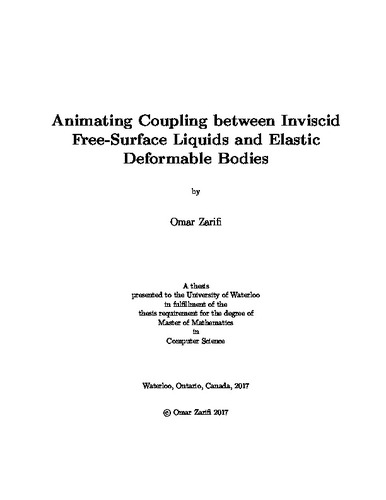| dc.description.abstract | Driven by demand for high-fidelity computer-generated imagery, physics-based animation has become an exciting frontier of research in computer science. Simulations of fluids and their interactions with other objects in the environment have particularly enjoyed much attention and investigation. Consequently, effective techniques have been developed to efficiently simulate two-way coupling between fluids and rigid bodies, allowing for convincing animation of, for instance, ships on the ocean. On the other hand, accurately capturing interactions between fluids and deformable solids has proven to be much more elusive. In particular, satisfaction of boundary conditions poses a significant difficulty, as the straightforward voxelized treatment suffers from visible grid artefacts, whereas use of a conforming mesh greatly increases the computational overhead of a simulation.
This thesis investigates the problem of animating two-way coupling effects between free-surface liquids and linearly elastic solids. Aside from presenting simulation techniques for such liquids and solids separately, we introduce a new approach to simulating their interactions that exhibits several notable advantages over previous techniques. By fully incorporating the dynamics of the solid into pressure projection, we simultaneously handle fluid incompressibility and solid elasticity and damping. Thanks to this strong coupling, our method does not suffer from instability, even in very taxing scenarios. Furthermore, use of a cut-cell discretization methodology allows us to accurately apply proper free-slip boundary conditions at the exact solid-fluid interface. Consequently, our method is capable of correctly simulating inviscid tangential flow, devoid of grid artefacts or artificial sticking. Lastly, we present an efficient algebraic transformation to convert the indefinite coupled pressure projection system into positive-definite form. The thesis also contains an evaluation of our proposed method, including several animation scenarios, as well as comparisons to previous techniques. | en |

